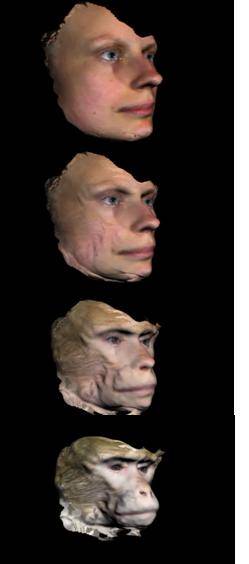|
FEATURE:
ICPR2006 Track 5 Invited Talk2 |


|
Kernel Machines for Computer Graphics
(Professor, MPI for Biological Cybernetics, Germany) |
|
Review by: Michael Reiter Vienna University of Technology
In this invited talk, Professor Bernhard Schölkopf presented applications of machine learning methods to problems in the field of computer graphics, in particular implicit surface modeling and computation of morphs between two 3D shapes of a certain object class (e.g., human heads). The learning methods used are kernel methods, such as Support Vector Machine Regression (SVM-Regression), which have become a standard tools in the field of computer vision and pattern recognition but are relatively new in the computer graphics community.
An implicit surface model of an object is constructed using an SVM-regression based implicit surface fitting framework. The object is modeled by a signed distance function which takes on values greater than zero outside the object and values less than zero inside the object. By definition the zero set of the signed distance function corresponds to the surface of the object. Essentially, for implicit surface fitting a regularized SVM-regression method is used where the input are sample points and normal vectors of the objects surface. A novelty of the approach is that normal vectors can be directly incorporated in the SVM surface fitting framework. The approach is characterized by fast fitting and good interpolation properties and high compression ratios, since only a small number of basis functions are used to represent the shape.
As was demonstrated in the talk by impressive 3D examples, SVM-based learning can also be employed for estimating dense deformation fields between objects. For example, a morph between the 3D head model of two individuals (male and female) was computed by the method. Although the 3D models where only roughly aligned and no landmark point correspondences were used, the point correspondences are found implicitly by the algorithm, such that in the continuous transition of one head model to the other, facial points such as eyes, nose, mouth and ears of the two models are accurately warped onto each other. This is accomplished by utilizing information about the surface normals in a local neighborhood of surface points. It is implemented in the regularized SVM-regression framework by incorporating gradients of the signed distance function into the penalty term of the cost function. Additionally, in some difficult cases where the point correspondences are not correct, a few manually annotated landmark points can improve the performance.
Overall, the results shown were very impressive, and Bernhard Schölkopf concluded that the applications serve as encouraging examples to show the potential of machine learning methods for shape processing tasks. |

|
Continuous morphing from one head model to another using regularized SVM-regression framework. |